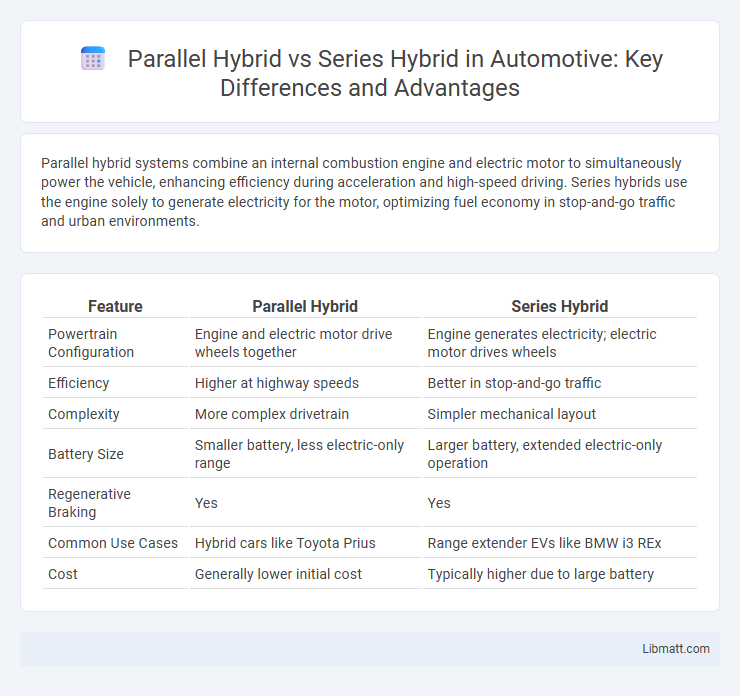Parallel hybrid systems combine an internal combustion engine and electric motor to simultaneously power the vehicle, enhancing efficiency during acceleration and high-speed driving. Series hybrids use the engine solely to generate electricity for the motor, optimizing fuel economy in stop-and-go traffic and urban environments.
Table of Comparison
| Feature | Parallel Hybrid | Series Hybrid |
|---|---|---|
| Powertrain Configuration | Engine and electric motor drive wheels together | Engine generates electricity; electric motor drives wheels |
| Efficiency | Higher at highway speeds | Better in stop-and-go traffic |
| Complexity | More complex drivetrain | Simpler mechanical layout |
| Battery Size | Smaller battery, less electric-only range | Larger battery, extended electric-only operation |
| Regenerative Braking | Yes | Yes |
| Common Use Cases | Hybrid cars like Toyota Prius | Range extender EVs like BMW i3 REx |
| Cost | Generally lower initial cost | Typically higher due to large battery |
Introduction to Hybrid Systems
Parallel hybrid systems combine an internal combustion engine and an electric motor to simultaneously power the vehicle, enhancing fuel efficiency and performance. Series hybrid systems use the internal combustion engine solely to generate electricity, which then drives the electric motor connected to the wheels, optimizing electric-only driving at low speeds. Both configurations contribute to reducing emissions and improving energy management in hybrid electric vehicles.
Overview of Parallel Hybrid Architecture
Parallel hybrid architecture combines an internal combustion engine and an electric motor connected to the vehicle's drivetrain, allowing both power sources to operate simultaneously or independently. This design enhances fuel efficiency by enabling electric-only driving at low speeds and engine-assisted power during acceleration. Your vehicle benefits from seamless power delivery and improved performance through the integration of both propulsion systems.
Overview of Series Hybrid Architecture
Series hybrid architecture features an internal combustion engine connected solely to a generator that produces electricity for the electric motor driving the wheels, eliminating a mechanical link between the engine and drivetrain. This setup allows the engine to operate in its optimal efficiency range, reducing fuel consumption and emissions. Energy management prioritizes battery charging and electric motor propulsion, enhancing performance in urban and stop-and-go driving conditions.
Key Components Comparison
Parallel hybrid systems integrate both an internal combustion engine (ICE) and electric motor connected directly to the drivetrain, allowing either or both to power the vehicle simultaneously, enhancing efficiency during acceleration and high-speed driving. Series hybrid systems feature an ICE that acts solely as a generator to produce electricity for the electric motor, which exclusively drives the wheels, simplifying mechanical design but relying heavily on battery capacity and electric propulsion. Your choice between these two hybrid configurations depends on desired mechanical complexity, power delivery, and fuel efficiency priorities.
Power Flow and Efficiency Differences
Parallel hybrid systems split power between the internal combustion engine and electric motor, allowing simultaneous or independent operation, which enhances efficiency during acceleration and reduces fuel consumption. Series hybrids rely solely on the electric motor for propulsion, with the engine acting as a generator to charge the battery, optimizing efficiency in stop-and-go traffic but potentially reducing overall power transfer effectiveness at high speeds. Your choice between parallel and series hybrids impacts power flow dynamics and operational efficiency based on driving conditions and performance needs.
Performance in Various Driving Conditions
Parallel hybrids deliver superior performance during acceleration and high-speed driving by combining power from both the internal combustion engine and electric motor directly to the drivetrain. Series hybrids excel in stop-and-go urban traffic, where the electric motor alone powers the vehicle, improving fuel efficiency and reducing emissions. Each system optimizes energy use based on driving conditions, with parallel hybrids favoring dynamic performance and series hybrids maximizing efficiency in low-speed scenarios.
Fuel Economy: Parallel vs Series
Parallel hybrid systems typically achieve better fuel economy during highway driving by allowing the internal combustion engine and electric motor to operate simultaneously, optimizing power delivery and reducing fuel consumption. Series hybrids excel in city driving conditions where electric motors handle low-speed propulsion, resulting in improved fuel efficiency through regenerative braking and smoother power transitions. Comparative studies show that parallel hybrids often outperform series hybrids in sustained high-speed scenarios, while series hybrids provide superior mileage benefits in stop-and-go traffic environments.
Real-World Applications and Examples
Parallel hybrids excel in real-world applications like the Toyota Prius, combining gasoline and electric power directly to enhance fuel efficiency and performance during everyday driving. Series hybrids, used in models such as the BMW i3 REx, rely solely on the electric motor to drive wheels while the engine acts as a generator, optimizing urban commuting with zero-emission benefits. Your choice between these systems depends on driving habits and priorities, with parallel hybrids favoring highway efficiency and series hybrids excelling in city environments.
Pros and Cons of Each System
Parallel hybrid systems offer improved fuel efficiency and reduced emissions by allowing both the engine and electric motor to drive the wheels simultaneously, enhancing performance during acceleration and providing regenerative braking; however, their complexity can increase maintenance costs and vehicle weight. Series hybrid systems simplify the drivetrain by using the internal combustion engine solely to generate electricity for the electric motor, resulting in smoother operation and better low-speed efficiency but often facing lower overall efficiency at highway speeds and limited direct engine power to the wheels. Choosing between parallel and series hybrids depends on balancing factors like driving conditions, cost, performance needs, and fuel economy priorities.
Choosing the Right Hybrid for Your Needs
Choosing the right hybrid system depends on your driving habits and efficiency goals. Parallel hybrids use both the engine and electric motor to power the wheels simultaneously, offering better performance and fuel economy in city driving with frequent stops. Series hybrids rely solely on the electric motor for propulsion, with the engine acting as a generator to recharge the battery, making them ideal for smooth, steady driving and maximizing electric range.
Parallel hybrid vs Series hybrid Infographic

 libmatt.com
libmatt.com